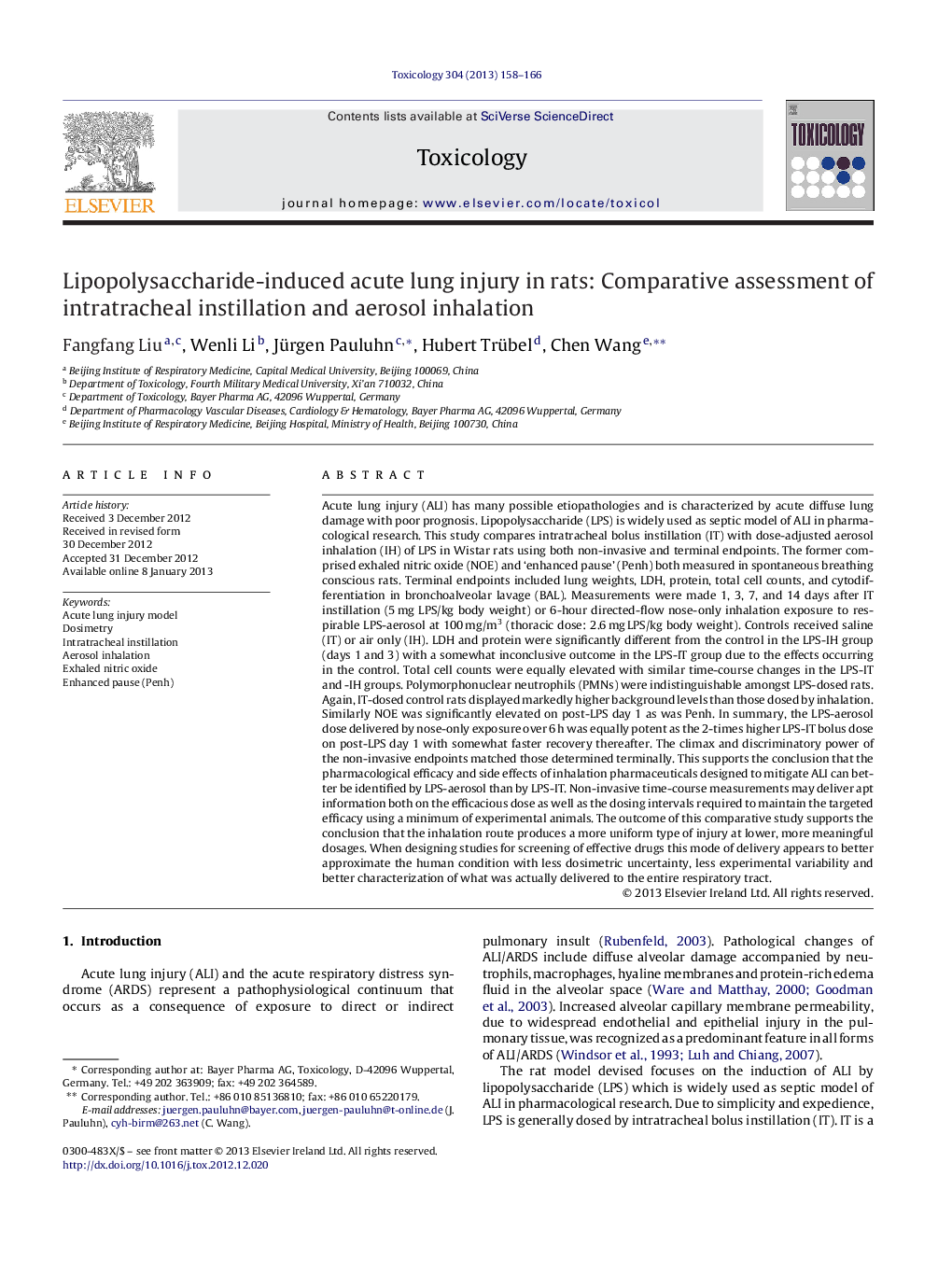| کد مقاله | کد نشریه | سال انتشار | مقاله انگلیسی | نسخه تمام متن |
|---|---|---|---|---|
| 5859414 | 1562352 | 2013 | 9 صفحه PDF | دانلود رایگان |
Acute lung injury (ALI) has many possible etiopathologies and is characterized by acute diffuse lung damage with poor prognosis. Lipopolysaccharide (LPS) is widely used as septic model of ALI in pharmacological research. This study compares intratracheal bolus instillation (IT) with dose-adjusted aerosol inhalation (IH) of LPS in Wistar rats using both non-invasive and terminal endpoints. The former comprised exhaled nitric oxide (NOE) and 'enhanced pause' (Penh) both measured in spontaneous breathing conscious rats. Terminal endpoints included lung weights, LDH, protein, total cell counts, and cytodifferentiation in bronchoalveolar lavage (BAL). Measurements were made 1, 3, 7, and 14 days after IT instillation (5 mg LPS/kg body weight) or 6-hour directed-flow nose-only inhalation exposure to respirable LPS-aerosol at 100 mg/m3 (thoracic dose: 2.6 mg LPS/kg body weight). Controls received saline (IT) or air only (IH). LDH and protein were significantly different from the control in the LPS-IH group (days 1 and 3) with a somewhat inconclusive outcome in the LPS-IT group due to the effects occurring in the control. Total cell counts were equally elevated with similar time-course changes in the LPS-IT and -IH groups. Polymorphonuclear neutrophils (PMNs) were indistinguishable amongst LPS-dosed rats. Again, IT-dosed control rats displayed markedly higher background levels than those dosed by inhalation. Similarly NOE was significantly elevated on post-LPS day 1 as was Penh. In summary, the LPS-aerosol dose delivered by nose-only exposure over 6 h was equally potent as the 2-times higher LPS-IT bolus dose on post-LPS day 1 with somewhat faster recovery thereafter. The climax and discriminatory power of the non-invasive endpoints matched those determined terminally. This supports the conclusion that the pharmacological efficacy and side effects of inhalation pharmaceuticals designed to mitigate ALI can better be identified by LPS-aerosol than by LPS-IT. Non-invasive time-course measurements may deliver apt information both on the efficacious dose as well as the dosing intervals required to maintain the targeted efficacy using a minimum of experimental animals. The outcome of this comparative study supports the conclusion that the inhalation route produces a more uniform type of injury at lower, more meaningful dosages. When designing studies for screening of effective drugs this mode of delivery appears to better approximate the human condition with less dosimetric uncertainty, less experimental variability and better characterization of what was actually delivered to the entire respiratory tract.
⺠Results from dosimetrically adjusted inhalation studies with LPS aerosol match those following bolus intratracheal instillation. ⺠The recovery of inflammatory changes is faster following inhalation compared to instillation. ⺠Noninvasive measurements of exhaled nitric oxide (NOE) and Penh deliver robust information on LPS-induced lung inflammation. ⺠Both biomarkers of lung inflammation can be used for time-course analyses in drug-efficacy studies.
Journal: Toxicology - Volume 304, 8 February 2013, Pages 158-166
